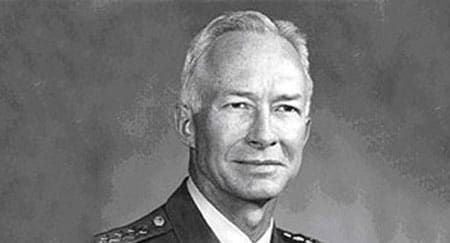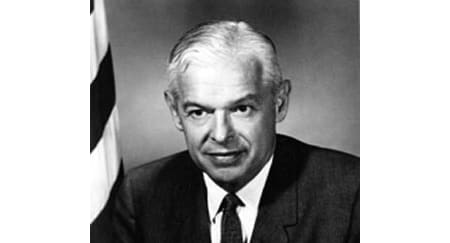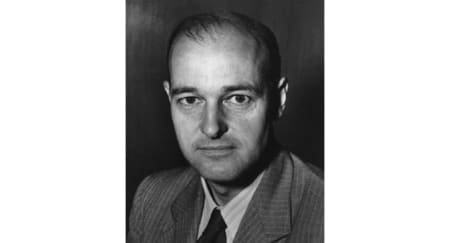Kenneth Weisbrode pays tribute to George F. Kennan, Paul H. Nitze and Andrew J. Goodpaster, three leading Cold-War strategists who all died recently.
An important milestone, noted perhaps only by Cold-War aficionados, that three men central to the waging of that war all died recently within the span of six months: George F. Kennan, Paul H. Nitze and Andrew J. Goodpaster.
Kennan is the best known of the three. During the Cold War, Kennan received most of the credit for fathering the "containment" policy that arguably won it. His death in March 2005 at 101 was second only to that of Pope John Paul II in the number of obituaries it inspired during the past year.
Nitze, who died in October 2004, aged 97, was less well known than Kennan but hardly an obscure figure. His funeral at Washington National Cathedral was attended by more than 1000 people. His career in and out of government extended from the Truman to the Reagan administrations. Kennan's by contrast ended in the mid-1950s, apart from a brief stint as John F. Kennedy's ambassador to Yugoslavia. If Kennan gave us the outline of a Cold War strategy, Nitze, in drafting much of what has become known as the most famous policy document of the era after Kennan's "Long Telegram" – National Security Memorandum No. 68 (NSC-68) of 1950 on United States Objectives and Programs for National Security – invented the mission for it. That was nothing less than saving civilisation from Soviet tyranny.
Kennan and Nitze were colleagues who did not always see eye to eye. Kennan hated NSC-68, for example, claiming he never intended his plan of containment to be militarised to such an extent, or to be extended beyond Europe. The document called for a three to four-fold increase in defence expenditure. But they remained cordial if occasionally wary of one another. Already the deaths of both men have been characterised as akin to those of John Adams and Thomas Jefferson in 1826: the yin and the yang of Cold War strategy – or as Nitze liked to put it, partners of a tension between opposites – uniting finally in death, the one following soon after the other.
This romantic picture is, unfortunately, a distortion. There is a third piece to the story, and a third figure, unknown but to a small but highly devoted group of insiders, who also died recently. Unlike Kennan and Nitze, Goodpaster, who passed away in May 2005, was a professional soldier, a four star Army General and former Supreme Allied Commander of NATO. He was also a close associate and friend of both men. It is impossible to understand the Cold War without including all three as intellectual poles of the same tent. There was not one policy, or two opposing doctrines, but rather a three-part synthesis which proved greater than the sum of its parts.
It is impossible to understand the Cold War without including Kennan, Nitze and Goodpaster as intellectual poles of the same tent
The person who deserves the most credit for grasping that synthesis was President Dwight D. Eisenhower. Goodpaster was his Staff Secretary – a position akin to today's National Security Adviser – and took part in nearly every meeting the President had, in addition to serving as his chief liaison to the foreign policy bureaucracy. It was not without justification that Goodpaster was known as "Ike's alter ego".
Stalin died soon after Eisenhower took office in 1953. There was much uncertainty over what and who would come next in the Soviet Union. The United States had just fought a costly war in Korea against Chinese and Soviet proxies; the Soviet Union now had its own atomic weapons; the Cold War had been militarised and globalised. NSC-68 was proving accurate indeed.
But Eisenhower would have none of it. Containment was a compelling doctrine but Kennan's preferred tools – almost exclusively political and propagandistic – were no longer adequate. NSC-68 meanwhile provided minimal operational guidance. Full of dire predictions of world catastrophe, it did not offer a realistic blueprint for waging a long-term struggle against Communism apart from urging that the United States and its allies outspend and outman the Soviet Union at any given point of contestation around the world. It also offended Eisenhower's sense of fiscal prudence. He was obsessed with the potential for US defeat through waste and largesse. He understood that the Cold War had to be fought on many fronts, not least of which was economic – hence the "military-industrial complex" against which he warned in his farewell address. Eisenhower was preoccupied with it throughout his two terms as President, not just at the end.
What was he to do? Eisenhower did something more than merely commission another policy blueprint. He decided to "game" it, that is, to set up three contending teams of advisers who would think through the implications of alternate policy approaches during the short, middle and longer term. The effort began in the summer of 1953 and culminated several months later. Because it was conceived and took place partly in the solarium of the White House, it became known as the Solarium Project.
The Solarium Project and the principal policy document resulting from it – NSC-162/2 – deserve to be remembered as one of the most significant group efforts in the history of US foreign relations. If one judges historical significance by eloquence or bureaucratic noise, then Kennan's Long Telegram and NSC-68 should retain their prominent positions. But if one also includes the impact of a given policy on the ground, then the Solarium Project should rank equally high. Solarium's three teams played out the entire Cold War. In retrospect, they did not do too badly in anticipating – in 1953 – the course it would ultimately follow. Taken together, they were remarkably prescient about the stakes for the United States and sensible about the various tools it would need to prevail.
Each team comprised about ten members from various parts of the foreign policy bureaucracy along with a few academics from outside. Team A – headed conveniently by Kennan – was bound to a mainly political strategy toward the Soviet Union, focused primarily on Europe, and eschewed significant military commitments elsewhere. It also relied heavily on US allies and placed a priority on alliance cohesion. Eisenhower gave Team B a similar mandate but allowed it to take a harder line towards the Soviet Union, and instructed it to contemplate policies that relied less on allies per se and more on the US nuclear arsenal. It was given, therefore, a more unilateral mission but one that nevertheless held to a clear line against taking direct military action within the Soviet sphere of influence. Team C was the "roll-back" team. Nitze was excluded from the project but Team C's mandate was taken almost verbatim from the prescriptive passages of NSC-68: diminish Soviet power – and Soviet-controlled territory – everywhere and by any means available. Eisenhower assigned Goodpaster to Team C, not because Goodpaster was known to sympathise with the roll-back approach but because he trusted his aide's integrity and knew Goodpaster would ensure that Team C produced a solid report.
The results were exactly as Eisenhower had intended. Roll-back and NSC-68 were tossed into the dustbin of history, or at least until Ronald Reagan resuscitated aspects of them under very different circumstances. Solarium Project participants concluded that the logical result of a roll-back policy – in the context of the 1950s – would be catastrophic. Team A meanwhile proved to be effective at managing a united Western front but found itself too hamstrung by military weakness and shifting European politics, particularly in Germany. Team B came out somewhere in the middle: a growing nuclear arsenal kept the Soviets at bay but the United States found itself carrying the burden of Western defence alone.
Eisenhower then summarised the teams' findings in a presentation that Kennan said "demonstrated the President's intellectual ascendancy over every man in the room". Goodpaster asked: "Does that include you, George?" To which Kennan replied: "Yes it does, because only the President has proven himself able to grasp the full range of political and military aspects of the policies under consideration."
Debate over whether or how the United States won the Cold War will continue for decades; but it is certain that Eisenhower's synthesis made survival possible. He transformed an ambivalent doctrine of containment into a workable policy of deterrence. Kennan's preference for propaganda, covert action and political pressure was insufficient. Nitze's plan was too risky and inexact. The two approaches required a synthesis that deterred Soviet aggression while maintaining a common front with US allies and limiting the domestic costs of a long and expensive struggle. The strategy – put forth in NSC-162/2 – struck such a balance and proved enduring, not least because the diverse Solarium participants took part in a process designed for "each", as Eisenhower liked to say from his days at NATO, "in the presence of all".
The inner thoughts and conversations of the three men at this time are now lost. But the remainder of their lives suggests a pattern consistent with the role each played directly or indirectly in the Solarium Project. Each continued to both provoke debate and contribute to consensus over Cold War strategy. From his sinecure at Princeton, Kennan worked tirelessly to defend and redefine his understanding and prescription of containment in between writing several award-winning works of diplomatic history. Nitze continued to move in and out of government, serving as Secretary of the Navy and Deputy Secretary of Defense during the Vietnam era (when he became a closet dove), then resumed his earlier role as the leader of the Cold War hawks while negotiating nearly every major arms control treaty with the Soviet Union. Goodpaster went on to advise eight more Presidents, playing a quiet but critical role in the shadows, helping, for example, to convince Ronald Reagan to embrace Mikhail Gorbachev and his reforms, drafting the initial post-Cold War security arrangements for the states of Central and Eastern Europe, and helping the Pentagon plan for the overhaul of nuclear policy in the past couple of years.
The United States and the world survived the Cold War in part because these three men, and many like them, preserved the intellectual continuity that Eisenhower worried would be lost to political posturing. Each reminded leaders that there was no magic new strategy for meeting the Soviet challenge. US interests required a careful blend: Kennan with the faith in diplomacy and political pressure; Nitze with military preparedness; and Goodpaster with the safeguarding of deterrence. Each man, in his own unique way, was simultaneously soldier, scholar and statesman. The world is a less safe place today without them.



